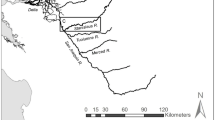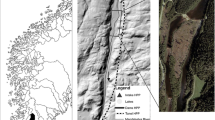Abstract
Using acoustic telemetry methods on large numbers of tagged fish, we studied how the holding behavior of Chinook salmon and steelhead smolts could be related to habitat features and spatial and temporal variables on a highly altered section of the Sacramento River. We viewed downstream migration as a process in which fish transition between moving and holding states, and used a binomial and negative binomial Generalized Linear Model to analyze two aspects of holding: 1) probability of holding, and 2) holding time. For Chinook salmon, the probability of holding increased as wood size and fine substrates increased; holding time increased as overhead shade increased. For steelhead, holding behavior was only weakly related to habitat variables, in contrast to the strong relationships with spatial and temporal variables. For both species, the probability of holding increased when distance from the release location decreased and instream flows decreased. We found support for three main findings: 1) spatial and temporal factors have considerably greater influence on Chinook salmon and steelhead smolt holding behavior than nearshore habitat features; 2) holding behaviors of Chinook salmon smolts are influenced more strongly by habitat features than steelhead smolts; and 3) incorporation of habitat features such as large woody material and overhead shade should be considered when conducting nearshore bank rehabilitation projects to increase cover from predators and provide velocity refuge, improving holding habitat during downstream migration.

Similar content being viewed by others
Notes
We chose to use 16 km upstream travel in single day based on telemetry results that indicated a range of 0.2 to 42.3 km for Chinook salmon and from 0.2 to 37.7 km for steelhead; only nine Chinook salmon and seven steelhead smolts were found to travel greater than 16 km upstream in a single day.
References
Beamer EM, Henderson RA (1998) Juvenile salmonid use of natural and hydromodified stream bank habitat in the mainstem Skagit River, northwest Washington. United States Army Corps of Engineers, Seattle
Blake A, Horn MJ (2003) Acoustic tracking of juvenile chinook salmon movement in the vicinity of Georgiana Slough, Sacramento River, California - 2003 study results - Draft report. United States Department of the Interior, United States Geological Survey
Burau J, Blake A, Perry R (2007) Sacramento/San Joaquin River Delta - Regional salmon outmigration study plan: Developing understanding for management and restoration. http://baydeltaoffice.water.ca.gov/ndelta/salmon/documents/RegionalSalmonStudyPlan_2008.01.07.pdf. Accessed 14 January 2011
Cavallo B, Kurth R, Kindopp J, Seesholtz A, Perrone M (2003) Distribution and habitat use of steelhead and other fishes in the lower Feather River, 1999–2001. California Department of Water Resources, Division of Environmental Services, Interim Report SP-F10
Chapman ED, Hearn AR, Michel CJ, Ammann AJ, Lindley ST, Thomas MJ, Sandstrom PT, Singer GP, Peterson ML, MacFarlane RB, Klimley AP (2012) Diel movements of out-migrating Chinook salmon (Oncorhynchus tshawytscha) and steelhead trout (Oncorhynchus mykiss) smolts in the Sacramento/San Joaquin Watershed. Environ Biol Fish. doi:10.1007/s10642-012-0001-x
Friesen TA, Vile JS, Pribyl AL (2007) Outmigration of juvenile chinook salmon in the lower Willamette River, Oregon. Northwest Sci 81(3):173–190
Giorgi AE, Hillman TW, Stevenson JR, Hays SG, Peven CM (1997) Factors that influence the downstream migration rates of juvenile salmon and steelhead through the hydroelectric system in the Mid-Columbia River Basin. N Am J Fish Manag 17:268–282
Hall JE, Chamberlin J, Kagley AN, Greene C, Fresh KL (2009) Effects of gastric and surgical insertions of dummy ultrasonic transmitters on juvenile chinook salmon in seawater. Trans Am Fish Soc 138:52–57
H. T. Harvey & Associates, PRBO Conservation Science (2010) Final interim (year-2) critical erosion levee repair sites fish and habitat monitoring report. Department of Water Resources, Division of Flood Management, Sacramento
H. T. Harvey & Associates, PRBO Conservation Science (2011) Draft critical erosion levee repair sites fish and habitat monitoring – Year-3 (2010) monitoring report. Department of Water Resources, Division of Flood Management, Sacramento
McLain J, Castillo G (2010) Nearshore areas used by fry chinook salmon, Oncorhynchus tshawytscha, in the northwestern Sacramento-San Joaquin Delta, California. San Franc Estuary Watershed Sci 7(2):1–12, http://deltarevision.com/2010%20docs/eScholarship%20UC%20item%204f4582tb.pdf. Accessed 24 January 2011
McMichael GA, Eppard MB, Carlson TJ, Carter JA, Ebberts BD, Brown RS, Weiland M, Ploskey GR, Harnish RA, Deng ZD (2010) The juvenile salmon acoustic telemetry system: a new tool. Fisheries 35(1):9–22
Michel C (2010) River and estuarine survival and migration of yearling Sacramento River chinook salmon (Oncorhynchus tshawytscha) smolts and the influence of environment. Master’s thesis, University of California Santa Cruz, Santa Cruz, CA
Mount J (1995) California rivers and streams: The conflict between fluvial process and land use. University of California Press, Berkeley
Perry RW, Skalski JR, Brandes PL, Sandstrom PT, Klimley AP, Ammann A, MacFarlane B (2010) Estimating survival and migration route probabilities of juvenile Chinook salmon in the Sacramento-San Joaquin River Delta. N Am J Fish Manag 30:142–156
RDCT (R Development Core Team) (2009) R: A language and environment for statistical computing. R Foundation for Statistical Computing, Vienna
Shahcheraghi R, Chu A (2011) Status and trends—Delta water project operations. IEP Newsl 24(1):6–9
Smith DL, Nestler JM, Johnson GE, Goodwin RA (2010) Species-specific spatial and temporal distribution patterns of emigrating juvenile salmonids in the Pacific Northwest. Reviews Fish Sci 18(1):40–64
Southard SL, Thom RM, Williams GD, Toft JD, May CW, McMichael GA, Vucelick JA, Newell JT, Southard JA (2006) Impacts of ferry terminals on juvenile salmon movement along Puget Sound shorelines. Washington State Department of Transportation, Olympia
Steel EA, Guttorp P, Anderson JJ, Caccia DC (2001) Modeling juvenile salmon migration using a simple Markov chain. J Agric Biol Environ Statistics 6(1):80–88
Stillwater Sciences, Dean Ryan Consultants (2004) Standard assessment methodology for the Sacramento River Bank Protection Project. United States Army Corps of Engineers, Sacramento
Williams JG (2006) Chapter 5: juvenile migration. San Franc Estuary Watershed Sci 4(3):69–109
Zuur AF, Ieno EN, Walker NJ, Saveliev AA, Smith GM (2009) Mixed effects models and extensions in ecology with R. Springer Science + Business Media, LLC, New York
Acknowledgments
We thank the California Department of Water Resources for funding this project [Agreement # 4600007998], specifically William O’Leary, Deborah Condon, and Kip Young for their support and guidance. We also thank the Interagency Flood Management Collaborative Program Critical Repairs Technical Task Group representatives for their support and feedback throughout the project. We also owe thanks to the many individuals that assisted in our data collection over the years: Laura Bauman, Steve Carpenter, Scott Demurs, Neil Kalson, Steve Kramer, Catherine Little, Trevor Lucas, Charles McClain, Amy Rauth, and Patrick Reynolds. Special thanks to Robert Abbott for deploying three receivers at our sites. We also thank the California Fish Tracking Consortium for providing data that we used for our analyses; NMFS staff Arnold Ammann and Cyril Michel, and UC Davis researchers Phil Sandstrom and Mike Thomas were particularly helpful. Sheri Woo, Christine Hamilton, Ron Duke, Adam Wagschal, and Samatha Moturi greatly improved the quality of this manuscript.
Author information
Authors and Affiliations
Corresponding author
Rights and permissions
About this article
Cite this article
Zajanc, D., Kramer, S.H., Nur, N. et al. Holding behavior of Chinook salmon (Oncorhynchus tshawytscha) and steelhead (O. mykiss) smolts, as influenced by habitat features of levee banks, in the highly modified lower Sacramento River, California. Environ Biol Fish 96, 245–256 (2013). https://doi.org/10.1007/s10641-012-0060-z
Received:
Accepted:
Published:
Issue Date:
DOI: https://doi.org/10.1007/s10641-012-0060-z




